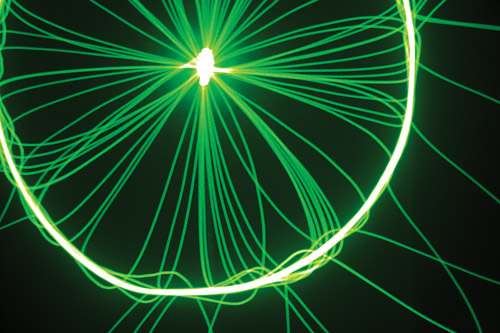The Proof of Concept exhibition is a recent photo exhibition of photographer Robin Fox, who in the exhibition shows photos which are exploring the concept of synaesthesia via the electrical signal equivalence. Actually the pictures focus mainly on the process of conversion of sound electricity to visual electricity. In the process use of different instruments like oscilloscopes and laser projectors of different types are shown. Robin Fox is one of the most renowned photographers in recent times and his photos of abstract things have created a stir in the photographic World.
The subject and concept of the exhibition is as unique as it can be and the gallery is the best place where the photos can be exhibited. Diffused lighting and pastel shaded walls really add to the mystical effects of the magic of the energy conversion that has been represented in the pictures. Every photo is facing a light from the ceiling and this is probably adheres to the fact that the medium only requires a single source of light and it is enough for creating a persistence of vision and finally consents with the algorithms of sound that are dealt here.
The linear sequence of the series is nothing but a silent witness of a huge energy changing process. There are seven pictures in the series of photos. In our discussion we choose one of them. If we look at the picture it will appear that the photo consists of a circular ray of fluorescent lights, which is joined by many small light rays from the centre. As it is one with a black background, it appears to be more illuminated. But, the picture is a scientific marvel if we look at it closely (Skrebowski 2009).
In this segment of discussion we will discuss about the picture of Robin Fox which is entitled Proof of concept. Like all other pictures exhibited in the exhibition, the photograph is also a Type C print. It is of 118 X 166cm in the size.

Like all the other photos in the series, this is also an exploration of the area of synaesthesia along with the electrical signal equivalence. The basic idea of the picture is to capture the conversion process of the sound electricity into visual electricity and that provides the fluorescent effects of the picture. As the back ground is dark, it seems that the conversion and power of energy are beaming out from the photograph.
Here the artist used two mediums both audio and the visual ones to get the desired effects while taking the photograph and the main aspect of using both the mediums is that both of them actually require a single light source and they try to move it with enough speed to create the effect of persistence of vision. This process allows the light to go through the recording medium, which is the film and creates those unique effects. The photograph, along with all the other photographs represents after-images as the photographic terms tell (Phillips 2009).
Basically the most important part of the photograph is that it can be also dubbed as slices of time that contains some difficult algorithms, which are presented on a photographic plate. In short, all the photographs in the series are silent observers to a major process of nature, the transfer of power into a different form. This idea makes the photography exhibition so special in nature.
Reference list
Phillips, D., 2009. Automatism, Causality and Realism: Foundational Problems in the Philosophy of Photography, Philosophy Compass, 4 (1), pp. 1-21.
Skrebowski, L., 2009. Productive Misunderstandings: Interpreting Mel Bochner’s Theory of Photography, Art History, 32 (5), pp.910-931.